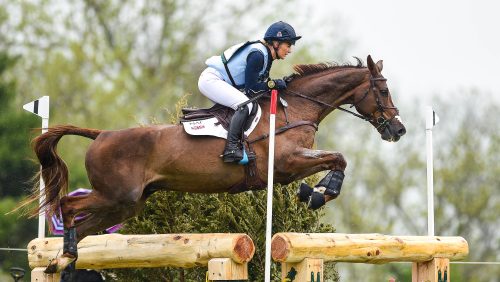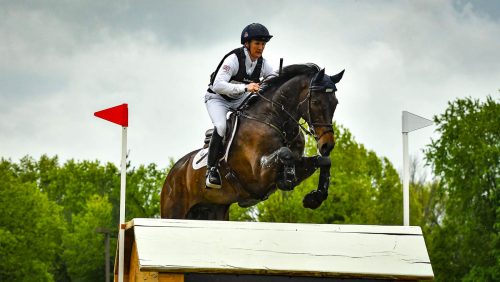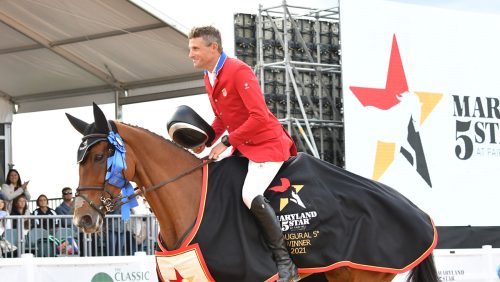Have you ever thought about a dressage schooling session as the equivalent of a workout at the gym? According to U.S. eventing chef d’equipe David O’Connor, you should.
During the first day of the Feb. 3-5 U.S. Equestrian Federation High Performance Training Sessions in Ocala, Fla., O’Connor reminded riders of two main purposes of dressage: physical therapy and communication. Eight horse/rider pairs had private dressage lessons on Feb. 3.
First, O’Connor got updates on the horses, an overview of winter progress, and discussed competition plans moving forward as riders looked toward the Alltech FEI World Equestrian Games. As the sessions got underway, clear themes emerged. For some, O’Connor focused on solidifying the foundations of dressage. For others, the sessions progressed to ringcraft.
Up The Game
Sharon White rode the 10-year-old gelding Wundermaske in the first session. When I asked White what she hoped to get out of the training sessions, she quipped, “I
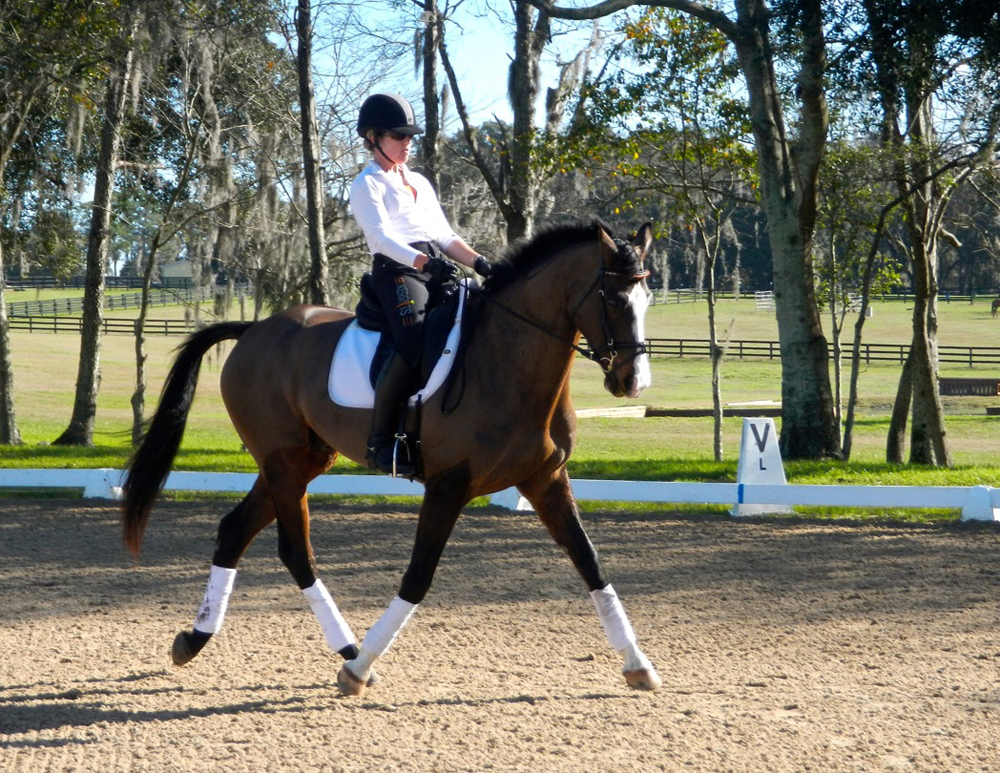 |
| Sharon White used leg-yields in medium trot to help maximize Wundermaske’s trot. Photo by Kristin Carpenter |
would love to take 5 points off my FEI dressage score for each day of the sessions!” She seemed well on her way, as her lesson focused on maximizing the horse’s engagement and rider accuracy. Wundermaske has good natural gaits and O’Connor warned White not to be complacent, and to constantly “up the game” and “ask for more.”
As Wundermaske is one of the younger horses participating, O’Connor stressed the need for leg yields in medium trot to establish more power in the trot. However, O’Connor warned that one must be careful when asking for more engagement and impulsion in these exercises, and only press for five steps, then allow the horse to move freely forward. When considering dressage as physical therapy, the strengthening work should be treated like repetitions in the gym: attain quality reps, and then take a break.
Bruce Davidson, Jr. rode both Park Trader and Petite Flower in the sessions today. Flower is known for her scopey jump, and Buck has been working to improve the mare’s dressage.
ADVERTISEMENT
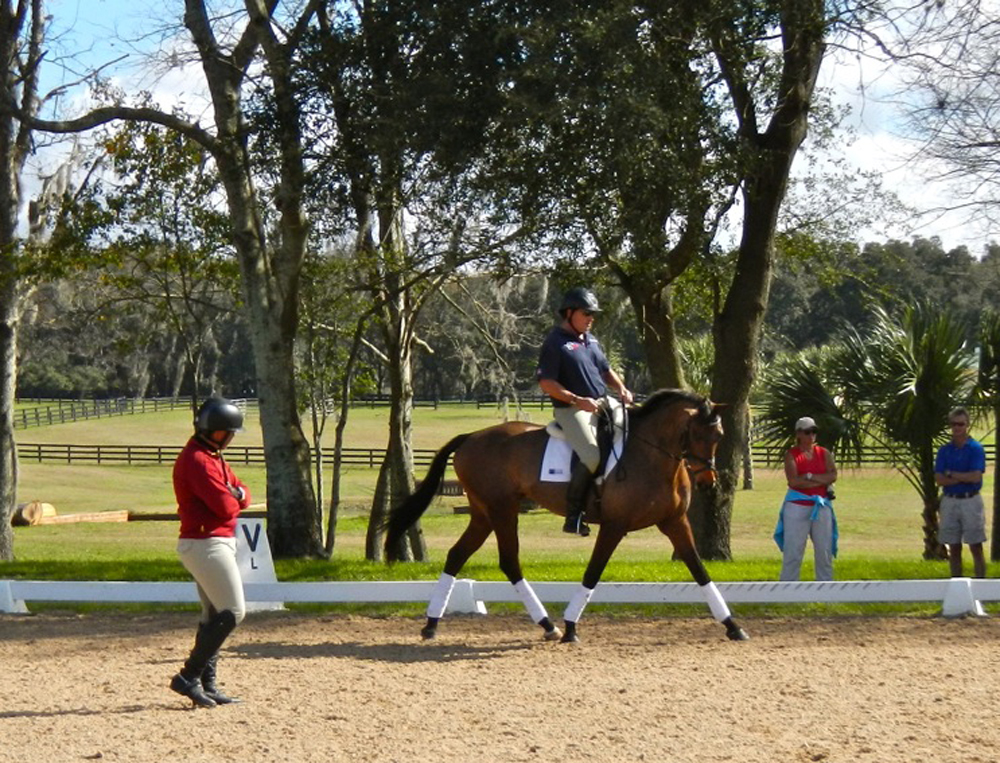 |
| Buck Davidson watched David O’Connor ride Petite Flower and demonstrate the importance of an effective half-halt. photo by Kristin Carpenter |
To work on communication, O’Connor emphasized the use of the outside rein. During every lesson there was a focus on the quality of the half-halt through the outside rein. Some of the horses tended to tense their backs when the riders half-halted, while others would swing their haunches off the line. O’Connor rode many of the horses and he spent time at all three gaits establishing a halt-halt on the outside rein that led to the horse lifting its back and engaging the hind leg while staying true to the line of travel.
O’Connor stated that this quality of contact is imperative; all too often he sees riders with “busy hands” who create hard mouths in their horses. He encouraged riders to fix contact issues by addressing the horse’s body instead of making corrections on the rein. Specifically, he warned many riders against the use of an indirect inside rein in the attempt to lift the inside shoulder.
Lynn Symansky rode her own Donner. When I asked about her goals for the coming year, Symansky said, “Last year, we were focused on experience at the four-star level. This year is about collecting the tools to be competitive at that level. With Donner turning 11, he is coming into his body and I am now able to really put pressure on him and increase rideability.”
Donner was quite fresh for his session, and this early in the season many of the horses spent a large portion of their lessons working through tension. For Donner. Symansky worked on lowering the horse’s head and neck while asking him to reach through the rein to carry the bit forward. “When you give the rein to stretch,” O’Connor reminded, “the horse should reach forward to take the bit. If they don’t, then they are not going correctly.” For a true stretch, he prompted Symansky to lower the horse with the outside rein and only use the inside rein to guide.
O’Connor continued his focus on contact for communication, and used Donner as an example of how to get a horse to yield despite beginning with tension. He stated that when a horse comes out incredibly forward, a rider must harness that energy in the work they ask the horse to do, and neither to simply work to exhaust the horse nor to fight against it.
Ringcraft: Getting Every Point
Sinead Halpin had the first session of the afternoon on Manoir de Carneville. As one of the more established pairs, their session focused less on solidifying “Tate’s” dressage work and more on Halpin’s accuracy and showmanship in the ring. Like White, Halpin was pressed to expand the range of the horse’s gaits by working to the extremes. This translated to lengthening and collecting in the shoulder-in at trot and working on the start of pirouettes in canter.
Once Tate was sufficiently supple, O’Connor worked with Halpin on corners, centerlines, and halts. Tennis balls were placed 4 meters from each corner, and the riders were told to ride consistently. “Your responsibility in the corners is for the consistency of what you do every single time,” O’Connor stated. He told Halpin that her corners appeared to be slightly reactive, as if she was making corrections during the corner, instead of riding more proactively to enter the corner with the balance and tempo desired.
ADVERTISEMENT
O’Connor broke down the corner into three sections. For the approach, he encouraged Halpin to always think of a “1/4 halt” 5 meters before, then maintain balance through the corner, then a “1/16 halt” 4 meters after. If the horse was not adequately on the outside aids and balanced after the first half-halt, he encouraged her to make a tiny half-halt in the actual corner. The before and after aids, however, must be the same every time. He posited that it is only with this level of consistency that a horse can learn the balance needed to come out of a corner and execute the next movement on the very first stride.
While every horse was in a unique place in their development, O’Connor harped on the need for consistency in both training and performance. His instruction was pointed, his methodology clear, and he rode many of the horses so that he could create the feel the riders needed to go to the next stage of their training. He required repeated execution to the highest standards, and did not conclude until he felt the riders clearly understood the session.
O’Connor stressed that the closer the riders got to perfection at home, the closer to perfection they’ll be in competition. He laughed that, “You are not going to go to the Olympics and have your 100 percent test.” But, he sternly stated, “Your 80 percent test has to be better than everyone else’s.”








